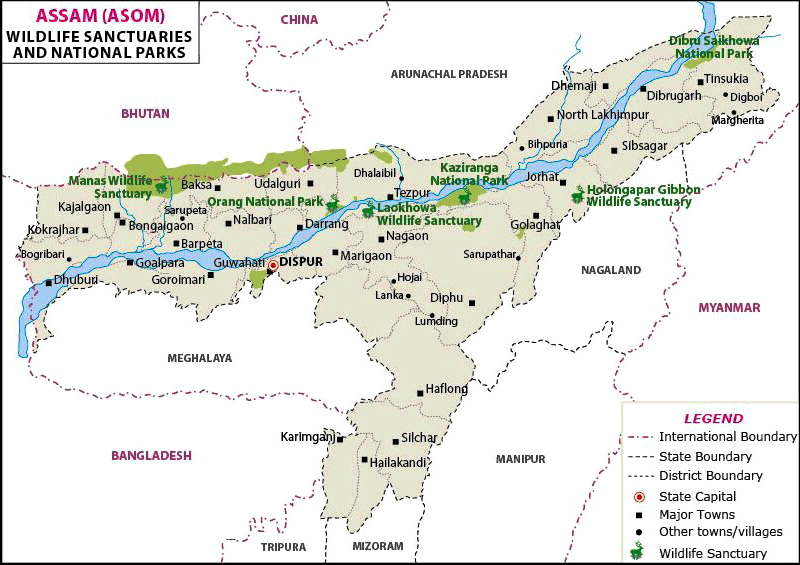Greater One-Horned Rhino | 24 Mar 2021
Why in News
The claims by different political parties over significant reduction in poaching of Greater One-Horned Rhino has become an issue in Assam Assembly Elections.
- According to the Assam Forest Department, poaching has reduced by 86% in the last three years.
Key Points
- About:
- The Greater One-Horned Rhino is one among the five different species of Rhino. The other four are:
- Black Rhino: Smaller of the two African species.
- White Rhino: Recently, researchers have created an embryo of the northern white rhino by using In vitro Fertilization (IVF) process.
- Javan Rhino: Critically endangered in IUCN Red List.
- Sumatran Rhino: Recently gone extinct in Malaysia.
- There are three species of rhino in Asia—Greater one-horned (Rhinoceros unicornis), Javan and Sumatran.
- Only the Great One-Horned Rhino is found in India.
- Also known as Indian rhino, it is the largest of the rhino species.
- It is identified by a single black horn and a grey-brown hide with skin folds.
- They primarily graze, with a diet consisting almost entirely of grasses as well as leaves, branches of shrubs and trees, fruit, and aquatic plants.
- The Greater One-Horned Rhino is one among the five different species of Rhino. The other four are:
- Habitat:
- The species is restricted to small habitats in Indo-Nepal terai and northern West Bengal and Assam.
- In India, rhinos are mainly found in Assam, West Bengal and Uttar Pradesh.
- Assam has an estimated 2,640 rhinos in four protected areas, i.e. Pabitora Wildlife Reserve, Rajiv Gandhi Orang National Park, Kaziranga National Park, and Manas National Park.
- About 2,400 of them are in the Kaziranga National Park and Tiger Reserve (KNPTR)
- Protection Status:
- IUCN Red List: Vulnerable.
- Convention on International Trade in Endangered Species of Wild Fauna and Flora (CITES): Appendix I (Threatened with extinction and CITES prohibits international trade in specimens of these species except when the purpose of the import is not commercial, for instance for scientific research).
- Wildlife Protection Act, 1972: Schedule I.
- Threats :
- Poaching for the horns
- Habitat loss
- Population density
- Decreasing Genetic diversity
- Conservation Efforts by India:
- The five rhino range nations (India, Bhutan, Nepal, Indonesia and Malaysia) have signed a declaration ‘The New Delhi Declaration on Asian Rhinos 2019’ for the conservation and protection of the species.
- Recently, the Ministry of Environment Forest and Climate Change (MoEFCC) has begun a project to create DNA profiles of all rhinos in the country.
- National Rhino Conservation Strategy: It was launched in 2019 to conserve the greater one-horned rhinoceros.
- Indian Rhino Vision 2020: Launched in 2005, it is an ambitious effort to attain a wild population of at least 3,000 greater one-horned rhinos spread over seven protected areas in the Indian state of Assam by the year 2020.
Kaziranga National Park
- Location:
- It is located in the State of Assam and covers 42,996 Hectare (ha). It is the single largest undisturbed and representative area in the Brahmaputra Valley floodplain.
- Legal Status:
- It was declared as a National Park in 1974.
- It has been declared a tiger reserve since 2007. It has a total tiger reserve area of 1,030 sq km with a core area of 430 sq. km.
- International Status:
- It was declared a UNESCO World Heritage Site in 1985.
- It is recognized as an Important Bird Area by BirdLife International.
- Important Species Found:
- Much of the focus of conservation efforts in Kaziranga are focused on the 'big four' species— Rhino, Elephant, Royal Bengal tiger and Asiatic water buffalo.
- As per the figures of tiger census conducted in 2018, Kaziranga had an estimated 104 tigers, the fourth highest population in India after Jim Corbett National Park (231) in Uttarakhand, Nagarhole National Park (127) and Bandipur National Park (126) in Karnataka.
- Kaziranga is also home to 9 of the 14 species of primates found in the Indian subcontinent.
- Other National Parks of Assam:
- Dibru-Saikhowa National Park,
- Manas National Park,
- Nameri National Park,
- Rajiv Gandhi Orang National Park,
- Dehing Patkai National Park

